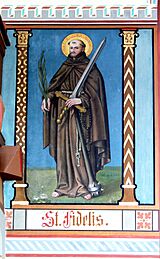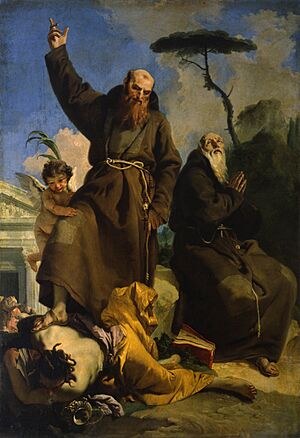Fidelis of Sigmaringen facts for kids
Quick facts for kids SaintFidelis of Sigmaringen OFM Cap. |
|
|---|---|

Fidelis von Sigmaringen
|
|
| Martyr | |
| Born | 1577 Sigmaringen, Principality of Hohenzollern-Sigmaringen |
| Died | 24 April 1622 (aged 44–45) Grüsch, Seewis im Prättigau, Free State of the Three Leagues |
| Venerated in | Catholic Church |
| Beatified | 24 March 1729 by Pope Benedict XIII |
| Canonized | 29 June 1746, Rome by Pope Benedict XIV |
| Major shrine | Capuchin friary of Weltkirchen (Feldkirch), Austria |
| Feast | 24 April |
| Attributes | sword; palm of martyrdom; heretics; morning star; trampling on the word "heresy"; with a club set with spikes; with a whirlbat; with an angel carrying a palm of martyrdom; with Saint Joseph of Leonessa |
Saint Fidelis of Sigmaringen (born Mark Roy or Rey) was a German Capuchin friar. He lived from 1577 to 1622. He played an important role in the Counter-Reformation, which was the Catholic Church's response to the Protestant Reformation. He was killed by his opponents in what is now Switzerland. The Catholic Church recognized him as a saint in 1746.
Contents
Early Life and Education
Mark Roy was born in 1577 in Sigmaringen, a town in modern-day Germany. At that time, it was part of the Principality of Hohenzollern-Sigmaringen. His father, John Rey, was from Spain. Mark studied law and philosophy at the University of Freiburg.
After his studies, Mark taught philosophy at the same university. He earned a special degree called Doctor of Law. During his time as a student, he was known for being very modest and kind. He also lived a very simple life.
In 1604, Mark became a preceptor, which means a teacher and mentor. He traveled across Europe with three young gentlemen from Swabia. For six years, he often went to Mass and visited hospitals and churches. He spent many hours praying and was very generous to people in need. Sometimes, he even gave away his own clothes.
When he returned, he became a lawyer in Colmar, France. People called him the 'poor man's lawyer' because he helped those who couldn't afford legal help. He was always fair and never tried to harm anyone's reputation. However, he became unhappy with some of the problems in his job. He decided to join his brother George and become a Capuchin friar.
Life as a Capuchin Friar
When Mark joined the Capuchin order, he was given a new religious name: Fidelis. This Latin word means "faithful." It was a reminder of a Bible verse that promises a special reward to those who stay faithful. He completed his training and studies to become a priest. He celebrated his first Mass on October 4, 1612, which is the feast day of St. Francis of Assisi.
After becoming a priest, Fidelis quickly began preaching and hearing confessions. He became the leader of the Capuchin friary in Weltkirchen, Feldkirch, in Austria. During a serious sickness outbreak in the city, Fidelis helped many sick soldiers. Many people in the town changed their lives because of his hard work. Several Calvinists even decided to become Catholic.
The Church leaders asked Fidelis to preach in Graubünden, which is now part of eastern Switzerland. Eight other Capuchin friars helped him in this mission.
Missionary Work and Threats
The Calvinists in that area were very angry about Fidelis's success. He was helping many people convert to Catholicism. They began to threaten his life, and Fidelis started to prepare himself for martyrdom, meaning dying for his faith. Despite the threats, he continued his work. Two Calvinist gentlemen, Ralph de Salis and another, were converted by his efforts.
Fidelis and his helpers went into Prättigau, a small area in Graubünden, on January 6, 1622. This day is known as the Feast of the Epiphany. His strong dedication made the Calvinists in that area even angrier. The local Bishop of Coire sent a detailed report about Fidelis's work to the Church in Rome.
On April 24, 1622, Fidelis went to confession and celebrated Mass. Then he preached at Grüsch. At the end of his sermon, he suddenly became silent. He looked up to Heaven, as if in a trance. He clearly told several people that he would die soon. He even started signing his letters, P. Fidelis, prope diem esca vermium, which means "Father Fidelis, in days ahead to become food for worms." After the service, he and some friends traveled to Seewis. His friends noticed he was unusually happy.
Martyrdom of Saint Fidelis

On April 24, 1622, Fidelis was preaching in a church in Seewis. He was protected by some Austrian soldiers. His goal was to help the people of Seewis return to Catholicism. During his sermon, Calvinist leaders outside called people to fight. Some people left the church to face the Austrian soldiers.
The remaining Catholics in the church convinced Fidelis to leave with the soldiers. He did, but then he returned alone to Grüsch. On his way back, he met about 20 Calvinist soldiers. They demanded that he give up his Catholic faith. Fidelis refused. Because he would not change his beliefs, they attacked and killed him.
A local story describes the event: He had gone to preach at Seewis and encouraged the Catholics to stay strong in their faith. After a Calvinist fired a musket at him in the church, the Catholics begged him to leave. He replied that death was a gain and a joy for him. He said he was ready to die for God's cause.
On his way back to Grüsch, he met twenty Calvinist soldiers and their minister. They called him a false prophet and told him to join their group. He answered, "I am sent to correct your false beliefs, not to join them. The Catholic religion is the faith for all time. I do not fear death." One of them hit him on the head with a sword, knocking him down. Fidelis got back on his knees. He stretched out his arms like a cross and said weakly, "Forgive my enemies, O Lord. They are blinded by anger and do not know what they do. Lord Jesus, have mercy on me. Mary, Mother of God, help me!" Another sword strike split his head. He fell to the ground in his own blood. The soldiers then stabbed him many times with their long knives. They also cut off his left leg. They said this was to punish him for traveling to preach to them so often.
Veneration and Legacy
It is said that a Catholic woman was hiding nearby when Fidelis was killed. After the soldiers left, she came out and found his eyes open, looking up at the sky. Catholics buried him the next day.
Soon after, the rebels were defeated by the imperial troops. This was an event that Fidelis had predicted. The Protestant minister who was involved in Fidelis's death was changed by this event. He publicly gave up Calvinism and joined the Catholic Church.
Six months later, Fidelis's body was found to be incorrupt, meaning it had not decayed. However, his head and left arm were separated from his body. These body parts were placed into two special containers called reliquaries. One was sent to the Cathedral of Coire and placed under the High Altar. The other was placed in the Capuchin church in Weltkirchen, Feldkirch, Austria.
Saint Fidelis's feast day in the Catholic Church is celebrated every year on April 24.
See also
 In Spanish: Fidel de Sigmaringa para niños
In Spanish: Fidel de Sigmaringa para niños
- Saint Fidelis of Sigmaringen, patron saint archive

